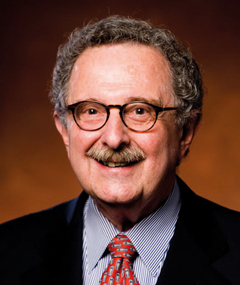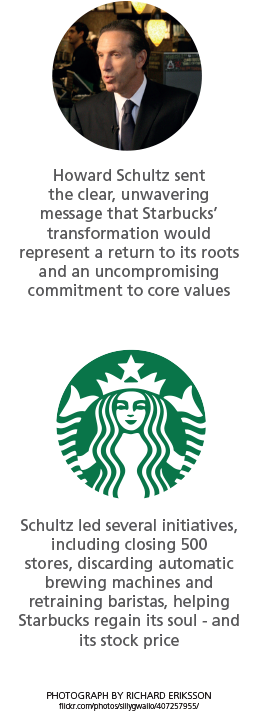Strategic reinvention is a powerful engine for value creation, but business leaders sometimes miss opportunities to harness it. Lloyd Shefsky uses examples from across sectors to help executives understand how to better identify and capture opportunities for reinvention in fast-changing global markets. Through the four case studies that he presents, Shefsky is able to demonstrate ways in which reinvention can be detrimental – losing sight of a businesses’ original vision and values – or beneficial, in cases whereby opportunities are identified to transfer capabilities into new markets and reinvention is inspired by lessons learned across markets, including foreign ones.
When Jim Donald, the third CEO of Starbucks, took office in 2005, no one seemed concerned about the succession. After all, the prior transfer from founder Howard Schultz to Orin Smith had been relatively seamless. Of course, Schultz and Smith had worked together nearly from the beginning. Smith had started as CFO, pre-IPO, and served as COO before becoming CEO, his office just yards from Schultz’s. As new CEO, Smith’s charge had been to carry on as Schultz had, ensuring Starbucks continued to be what it had been created to be: an appealing “third place” between home and work that served premium coffee.
When Smith passed the baton to Donald, the Board gave the third CEO a different charge: to expand the company dramatically, opening many new domestic and overseas stores to capture new markets, far faster than before. The strategy required multiple changes to improve operating efficiency. Soon it seemed that Donald had succeeded, with over 4,700 new stores opened during his three-year term, a large number of them outside the US.
Unfortunately, in late 2008, Starbucks’ operating results and stock price were hit hard. Most blamed it on the Great Recession, which enabled competitors like McDonald’s and Dunkin’ Donuts to steal market share by offering slightly elevated coffee products at lower prices. Amidst this challenge, Donald was replaced as CEO by founder Schultz. Even the Board probably would have agreed that Donald had just done as he’d been told – and it wasn’t his fault that the Starbucks model was based on high prices – but the falling stock price made everyone nervous.
Ultimately, Schultz examined the decline through his unique founder’s lens and found the problem wasn’t so much price but the loss of the company’s “soul”. Focusing exclusively on expansion and efficiency had robbed Starbucks of its essence, or what made it such an appealing destination. Schultz led several initiatives, including closing 500 stores, discarding automatic brewing machines and retraining baristas. All that helped Starbucks regain its soul – and its stock price. The takeaway is that it wasn’t quantity but quality that drove Starbucks’ success. Seeking global dominance by sheer scale led to the erosion of the cultural elements customers had come to expect from Starbucks.
How Schultz “reinvented” Starbucks is just one of many such stories I relate to in my book Invent Reinvent Thrive (McGraw-Hill, 2014). In some cases, such as that of Starbucks, leadership teams inadvertently don blinders that focus them excessively on one area – like expansion – and prevent them from seeing challenges (or opportunities) that require a different kind of approach, usually some form of reinvention. In other cases, executives get it right by executing timely reinventions in the face of shifting global markets. Reinvention can take place on multiple dimensions, from operational to cultural. The following stories illustrate the different ways reinvention pays off in dynamic business situations.
Charles Schwab Corporation
Chuck Schwab disrupted investment industry practices of inflated commissions, long justified by the bundling of unnecessary or unwanted research and reports. He offered much more efficient, transparent, and affordable brokerage services that made such offerings accessible to a larger population segment in the 1970s. He sold his namesake firm to Bank of America in 1983, but repurchased it in 1987 when he observed its challenges under new ownership. Schwab was able to grow the company again, but during the dotcom-boom, it faced mounting competition from more and more brokerage firms with innovative technology platforms.
Things got worse when Schwab left the firm in the hands of his former co-CEO. During our interview for Invent Reinvent Thrive, Schwab described the same kinds of problems Schultz had faced at Starbucks during the recession: executives had become overly focused on growth of revenues/profits, which led to more bloated structures/practices and higher commissions to cover these – the very thing Schwab had set out to combat in the first place in the 1970s. Schwab agreed heartily when I applied Pogo’s lament – “We have met the enemy, and he is us” – to describe his company’s situation at the turn of the millennium. Again like Schultz, Schwab returned to the business as CEO, and used the original culture and values with which he’d launched it to turn it around. Reinvention then, meant a return of both the founder and the company’s spirit, as a cure for blindness to the current business reality.
Levy Restaurants
Like Schultz and Schwab, Larry Levy was a visionary entrepreneur, but with a different focus: real estate. His Levy Organisation acquired extensive Chicago-area land, including the “One Mag Mile” building in the most premium section of the city’s Magnificent Mile shopping district. Levy developed the property in the early 1980s and, with his mother and brother, also opened several successful restaurants in the city’s Water Tower Place mall, anticipating demand for these kinds of venues before many existed.
Despite his business savvy and proven opportunism, Levy also had his blind-spots, especially the inability to see the potential for expanding food services to sports stadiums. “We’re not a food service provider,” he told Jerry Reinsdorf, the new owner of the Chicago White Sox baseball team in the 1980’s when Reinsdorf approached Levy to cater to the skyboxes he’d installed at the stadium, using day-old, re-warmed food from Levy’s restaurants. Levy worried about serving such offerings to the big spender sports fans who would sit in the premium boxes.
During our interview for Invent Reinvent Thrive, Levy admitted he’d been blind to the opportunity that the new target market represented. He was so focused on his restaurants and real estate that he failed to see how the skills he’d developed in those sectors positioned him to enter the sports-stadium catering business, which represented large growth potential, due to the number and size of such arenas US-wide. Thus, Levy was over-focused on his existing market until his executives convinced him to give the sports-focused business a shot. They argued it was actually a higher-profit, lower-risk business than restaurants and they were right. Levy’s firm grew dramatically in the new market, becoming a dominant player that still owns a large share today. So, this reinvention story is about being open to new markets where the business’ existing capabilities don’t seem a natural fit but are.
Costco
The story of retail warehouse Costco’s success is the story of founder Jim Sinegal and his ability to reinvent. After many years at the retailer Price Club, Sinegal left in the late 1970’s and launched Costco. He and his partners envisioned owning 12 retail stores that represented about $1 billion in total revenue. Today there are over 670 Costco stores worldwide, including in the US, Canada, Mexico, Korea, Japan, and Australia. Annual revenues total over $100 billion, or 100 times Sinegal’s early estimate.
Reinvention is at the heart of Costco’s success. Sinegal has been especially successful at adapting to local culture, both in the US and abroad. For example, his early attempts to open Midwestern US stores failed because he didn’t understand the culture, but he was able to conquer this region later after careful observation and application. His team transferred that kind of learning to overseas expansion as well. For example, they understood that they would have to configure stores differently in Korea, where land is at a huge premium. Instead of the sprawling stores and parking lots they constructed in the US, in Korea they used vertical space for their facilities.
Moreover, Sinegal mastered the art of keeping the retail experience fresh and entertaining for customers, another form of reinvention. That has meant adding everything from new food items (alcohol, meat, fish, fresh fruit, fresh-baked goods) to a pharmacy, to an optical department and even a gas station — first piloting changes in one or two stores before applying them on a wider scale. It also meant making free samples a Costco institution, with many customers admitting they eat an entire meal’s worth of food just from samples. These additions resulted in larger revenues per customer per trip, as people bought more items from more departments. Costco also began producing its own private-label goods. The idea of keeping the customer experience fresh has also been important because Costco stores are operated by managers with significant latitude, so they are able to experiment with addressing local tastes. Successful practices can then be transferred to other stores as appropriate.
Sinegal told his executives, “There’s no annuity [here]. You’ve got to continually add stuff that’s new and exciting. Otherwise you become boring.” Costco’s leadership team has achieved this continual reinvention while maintaining low prices — with consistent markups across products, instead of efforts to maximise profits on certain traditionally high-margin items like medication. That has meant retaining efficiency enablers like bulk packaging and the maintenance of no more than about 4000 items for sale (or SKU’s) at any given time across departments. Thus Costco masterfully illustrates two principles of reinvention explained in detail in Invent Reinvent Thrive: (1) reinvention needn’t be a complete overhaul, and can instead represent incremental changes over time; (2) reinvention should not shift the proven fundamentals of the business. In this way Costco can change product lines dramatically while retaining its brand/value proposition for customers.
Carlson
A final example of reinvention comes from the conglomerate of companies launched by Curtis Carlson starting in the late 1930s. The enterprise grew to include the Radisson Hotels, TGI Fridays Restaurants, and Carlson Wagonlit Travel. Curt’s daughter Marilyn succeeded him in the late 1990s, and her daughter Wendy Carlson Nelson joined the business after stints in professional tennis and private equity.
After serving as director of development for the restaurant business, the younger Nelson became an executive vice president within the hotel division, doing everything from working the front desk to making beds. Seeing opportunities for improvement, she made suggestions to fellow executives but made little progress – she suspected they failed to take her seriously because she had “been given her job.” But when she heard her peers suggest the business should “aspire to be one of the best,” the former tennis star was motivated to act. “Why play if we aren’t trying to be the best?” she recalled in our interview.
How Nelson drove change is a good example of reinvention. Concerned the domestic Carlson hotel brand was declining – and recognising that making suggestions hadn’t been enough to force action – she decided to show the leadership team the need for change by comparing the business’ well-established European hotel brand to its languishing American counterpart. Nelson went to Europe and brought back stories and pictures of a “brand with a soul,” then arranged for the executives to visit the best Europe-based properties followed immediately by a tour of their worst or average American hotels. She quickly secured buy-in from top executives, and her strategy was set into motion. The company continues to make good progress toward Nelson’s goal of being the best.
The Carlson example highlights the reverse form of culture-based reinvention from Costco’s. Where Jim Sinegal and his team used what they learned in the US about adapting to local cultures to expand successfully overseas, Nelson convinced her executives to apply lessons from overseas properties to those in the US. In both cases, the reinvention tactic galvanised management and led to smart strategies and mounting profits.
Fast-changing global business dynamics call for strategic reinvention. Whether it means a return to the heart and soul of a business as led by the founding visionary (Starbucks and Schwab), the transferring of core capabilities to a lucrative new market (Levy), or the transmission of local lessons to foreign markets or vice-versa (Costco and Carlson, respectively), reinvention has become an engine of profitability across sectors, geographies, and cultures. The good news is that it’s not a “magical” or proprietary solution; any executive can apply principles of reinvention by stepping back from their day-to-day operations, removing any blinders related to expansion or other overly narrow focuses, and thinking hard about solutions that keep the business fresh and relevant for customers while preserving its core essence. The stories in Invent Reinvent Thrive explain and teach those lessons in much greater detail.
About the Author
 Lloyd E. Shefsky serves and has served as a Director of several publicly and privately held companies. He is a Clinical Professor of Family Enterprises and Founder & Co-Director of the Center for Family Enterprises at the Kellogg School of Management and has taught in several countries. In 1970, he founded the Chicago law firm, Shefsky & Froelich Ltd., where he has been Of Counsel since 1996. In 2014, the firm merged into the Taft Law Firm, where he continues to serve as Of Counsel. For decades he represented the Government of Israel throughout the Midwestern U.S. Mr. Shefsky authored best-seller Entrepreneurs Are Made Not Born, which was translated into seven foreign languages, and last year authored Invent Reinvent Thrive. Both were published by McGraw-Hill. He received his J.D. from the University of Chicago Law School and a B.Sc. from De Paul University. He is also a Certified Public Accountant.
Lloyd E. Shefsky serves and has served as a Director of several publicly and privately held companies. He is a Clinical Professor of Family Enterprises and Founder & Co-Director of the Center for Family Enterprises at the Kellogg School of Management and has taught in several countries. In 1970, he founded the Chicago law firm, Shefsky & Froelich Ltd., where he has been Of Counsel since 1996. In 2014, the firm merged into the Taft Law Firm, where he continues to serve as Of Counsel. For decades he represented the Government of Israel throughout the Midwestern U.S. Mr. Shefsky authored best-seller Entrepreneurs Are Made Not Born, which was translated into seven foreign languages, and last year authored Invent Reinvent Thrive. Both were published by McGraw-Hill. He received his J.D. from the University of Chicago Law School and a B.Sc. from De Paul University. He is also a Certified Public Accountant.






























